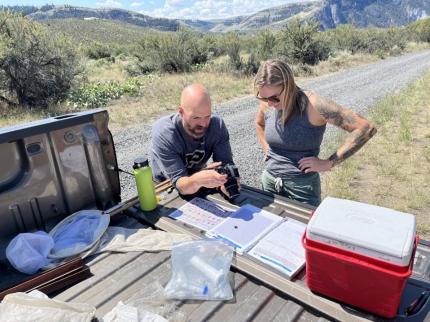
Wildlife Program report: Jun. 16-30, 2023
Providing Recreation Opportunities
The contract with TREAD for trails conditions assessment in Quincy Lakes is ongoing. Partnership Coordinator Browning and Recreation Planner Andersen are managing the contract and having weekly meetings with TREAD. Browning and Andersen have also been writing a scope of work for a trail inventory in Cowlitz and Methow wildlife areas that will begin in July.
Providing Education and Outreach
The Ambassador Program will be launching on July 1. Partnership Coordinator Browning has been coordinating volunteer talking points and logistics with the Washington Trails Association (WTA). WTA held an online training session the week of June 25.
Browning has been creating content for kiosks that will be delivered by June 30 to Region 4. Three panel kiosks are being designed currently for a few different locations around the state.
Other
Travel Management Rulemaking: Staff members recently held a meeting on several draft rules related to travel management. The draft rules will address illegal trail building, keeping motorized routes on roads that are open to that use, and adopt policy that would consider all routes closed unless designated open. There is a lot of internal (and outreach) work that needs to be done before the third rule can be pursued, but the official rulemaking process will begin on the other two.
Route Inventory: There has been a big effort to determine the process for inventorying all the roads and trails on WDFW managed lands. More recently staff members have developed a tool through a GIS app that contractors or interns can use to collect baseline data on each route, including those that are unauthorized. Now that we have a process in place, WDFW staff members are hoping to streamline the work and expand beyond the Columbia Basin and Methow wildlife areas to other wildlife areas across the state.
Utilizing Closures to Evaluate Recreation Impacts: WDFW natural resource economist, biologists, and staff members involved in the Methow Wildlife Area plan have been discussing the opportunity to use seasonal closures to measure the impacts of recreationists on mule deer habitat use and fitness. It might also be used to evaluate use patterns by the recreationists.
Managing Wildlife Populations
Bumble Bees: Biologist Brinkman, with cross-program assistance from Habitat Biologists Westerman and Kinnick, conducted follow-up bumble bee surveys in Lincoln County as part of the PNW Bumble Bee Atlas Project. These surveys were conducted in the same two locations as the surveys conducted earlier in June to provide information about changes to the flowering resources available and any changes to the diversity of bumble bee species captured. Several different species of bumble bees were captured at both survey locations.

Golden Eagles: Biologists Lowe and Brinkman assisted District 3 Biologist Vekasy, Research Scientist Watson, and two technicians with capture and marking of two golden eagle nestlings at a nest site near Central Ferry along the Snake River. One of these nestlings was fitted with a backpack GPS transmitter to monitor movements after fledging and track survival of this individual.
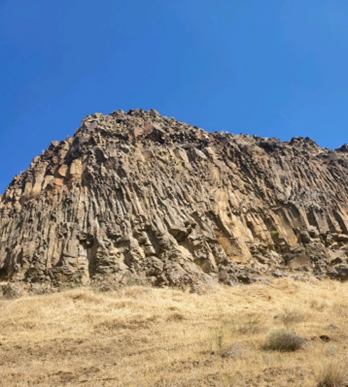
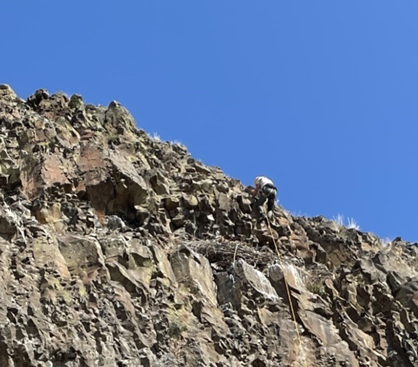
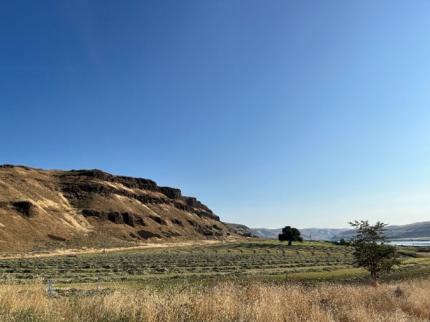

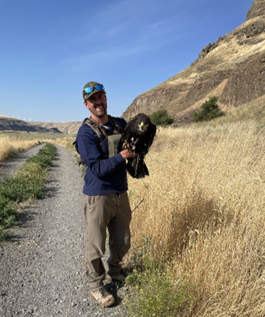
Ferruginous Hawk: Private Lands Biologist Hadley assisted Wildlife Research Scientist Watson and Assistant District 3 Wildlife Biologist Vekasy with tagging a ferruginous hawk fledgling, banding it for identification and then fitting one of the fledglings with a transmitter.
Providing Recreation Opportunities
Campsite Maintenance: Sherman Creek Wildlife Area Natural Resources Technician Zueger and Wildlife Area Assistant Manager Palmer felled a dead Douglas fir that was a hazard to a campsite at Sherman Creek, off Trout Lake Road. Palmer cut the tree down, and Zueger limbed it, gaining chainsaw experience.
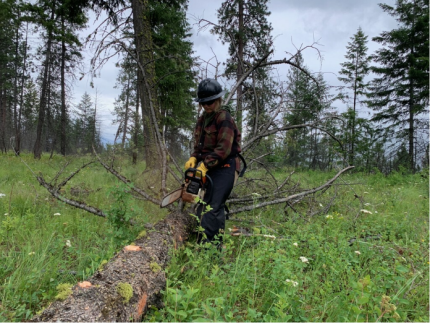

Tree Removal at Clear Lake: Brant used his new chainsaw training to take down a dead Ponderosa pine at the upper Clear Lake parking lot. A perfect cut dropped the tree where they wanted it! The pair bucked up the trunk and removed limbs, and will remove remaining debris later, after the trunk rounds have a chance to “walk away.”
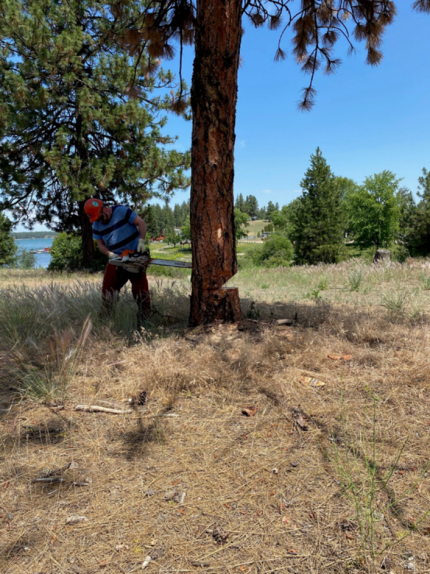
Vetter Farm Work Party: Natural Resource Technicians Harris and Janowski attended the Stevens County Conservation District (SCCD) Vetter Farm work party. Natural Resource Technicians Harris and Janowski assisted SCCD with building fence and planting a pollinator garden.
Habitat Work: Natural Resource Technician Nizer and Natural Resource Technician Rumiser mowed noxious weeds at a feel free to hunt property. Weeds will be evaluated and sprayed in the following weeks.
Providing Conflict Prevention and Education
Asotin County Elk: Natural Resource Technician Heitstuman conducted an early morning patrol in the Cloverland area. Several small groups of elk were in summer fallow fields. A large group was hazed out of a growing field. This field is due to be renewed for hunter access, contact was made with the listed owner.
Wolf Activity: Wildlife Conflict Specialist Kolb was visiting with a producer about elk damage when the producer mentioned that he observed seven wolves in a cattle pasture recently. Kolb contacted the producer and additional non-lethal deterrents were deployed across the pasture site.
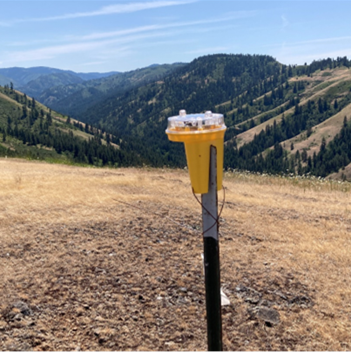
Livestock Depredation: WDFW Enforcement and Wildlife Conflict staff members investigated a domestic livestock mortality in Columbia County resulting in a confirmed cougar depredation. A male cougar was removed because of the confirmed depredation in close proximity to an occupied dwelling with children present.
Reported Possible Depredation in 139 Pack Territory: WDFW staff members responded to a report of a dead 2-year-old heifer being found by a producer who believed that it was likely a predator depredation. WDFW staff members investigated the depredation site and conducted a field necropsy. Staff members confirmed that it was a wolf depredation.
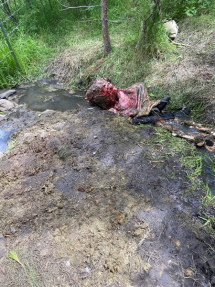
Turkey Feeding, Spokane Valley: Wildlife Conflict Specialist McCarty discussed concerns about neighbors feeding turkeys in a residential neighborhood and the potential for increased aggression toward humans if the birds were continually fed.
Outreach and Teamwork: Biologist Baarstad met with small forest landowners in Stevens and Pend Oreille counties to tour their properties and provide land management advice for forest stewardship and wildlife benefits. Baarstad worked with the Inland NW Wildlife Council, WDFW volunteers, and Technician Wagner to clear disabled hunter access routes on U.S Forest Service lands in Stevens and Pend Oreille counties.
Conserving Natural Landscapes
Habitat Coordination: Private Lands Biologist Hadley met with a Walla Walla Conservation District Voluntary Stewardship Program Coordinator to discuss areas of project coordination and focus areas.
Rocky Mountain Elk Foundation Grant: Natural Resource Technician Janowski completed a final project completion report and submitted the document to the Rocky Mountain Elk Foundation (RMEF). RMEF provided funding for a conifer tree planting in Stevens County and the organization requires a project report for their records.
Habitat Coordination: Private Lands Biologist Hadley met with a Walla Walla Conservation District and members of Blue Mountain Pheasants Forever Chapter to discuss coordination of future projects.
Providing Education and Outreach
Conservation District Partnership: Natural Resource Technician Nizer met with Whitman Conservation District to partner with a mowing project on a restoration site of theirs.
Conducting Business Operations and Policy
Budget: Wildlife Conflict Supervisor McCanna put together budget allotments for all Region 1 wildlife conflict and private lands staff members. McCanna sent to Budget Analyst Quinton to plan for the 23-24 fiscal year.
Hunt by Reservation Renewal: Natural Resource Technician Nizer and Natural Resource Technician Rumiser met with Spokane, Park, Recreation, and Golf Executive Director Chase to discuss renewing the reservation for Mica Peak for an additional five years. Chase was pleased with the last contract period and is interested in joining for another five years.
Wolf Advisory Group Meeting: Wildlife Conflict Supervisor McCanna attended the Wolf Advisory Group (WAG) field trip on Monday, in Clarkston looking at several different grazing allotments and their challenges. They then met with several producers in the 139-wolf pack territory in the Anatone area to hear their challenges with the recent confirmed and probable wolf depredations. Tuesday and Wednesday, McCanna attended the in-person WAG meeting in Clarkston.
Providing Recreation Opportunities
Sunnyside Bats: Sunnyside Snake River Wildlife Area Manager Kaelber, Assistant Manager Jahns, and Technician Manderbach conducted an emergent count of the Sunnyside bat maternal colony as they exited their roost after sunset. There were 112 adult bats observed, as well as approximately 15 young pups in the roost.
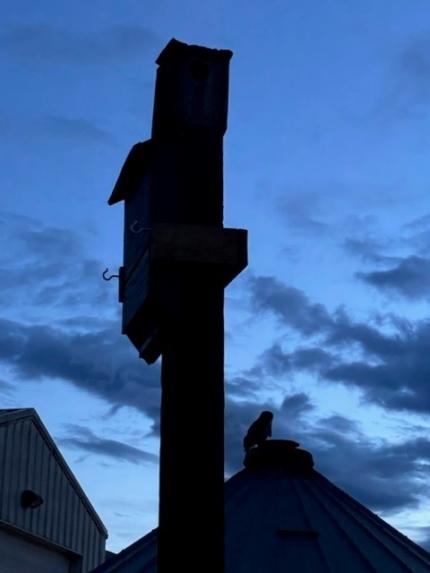
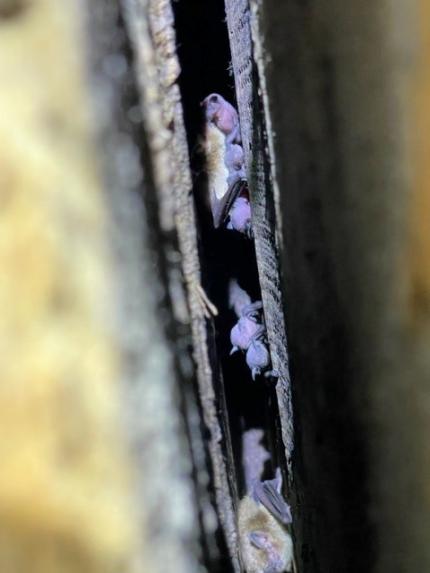
Burrowing Owl Tracking Project: Wildlife Biologist Fidorra finished up trapping burrowing owls for the pilot study on adult male habitat use and movements. WDFW and partners including Conservation Northwest and local Audubon chapters funded the placement of ten transmitters on adults with a few additional juvenile tags going out in support of an Environment Canada project to study juvenile movements, dispersal, and survival. All data will be helpful in understanding and reversing the apparent decline of Pacific Northwest burrowing owls.
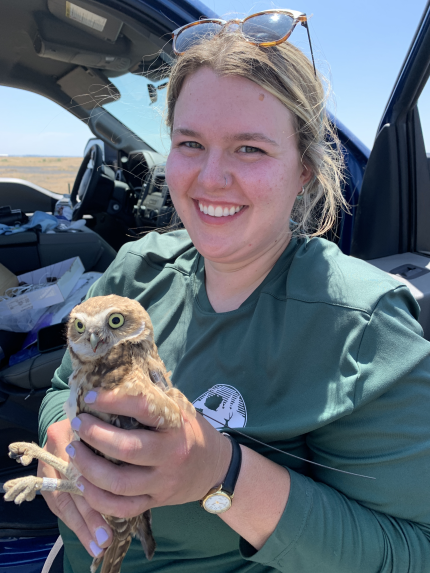
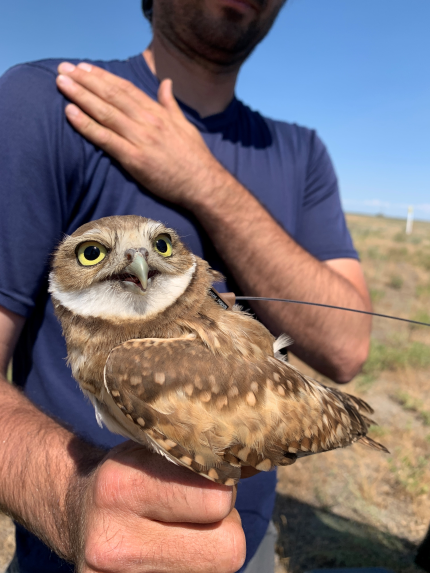
Providing Recreation Opportunities
Parking Lot Development: Colockum Wildlife Area staff members worked on improving a primitive parking area near the wildlife area headquarters. Original plans called for grading the site, asphalt paving and installation of fencing, signage and shade structures. A pre-project cultural resource survey determined the area qualified as a cultural resource site, precluding any grading, post hole digging ,or soil disturbance. Staff members used other methods to improve the site while minimizing disturbance.
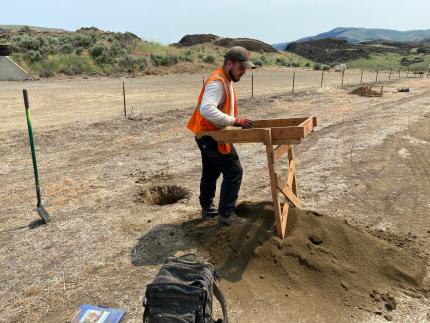
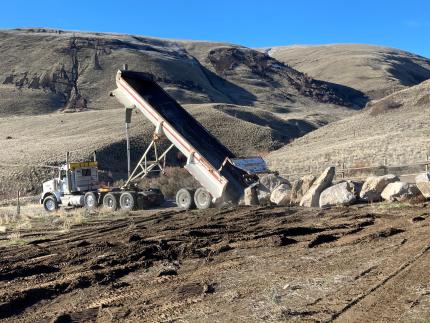
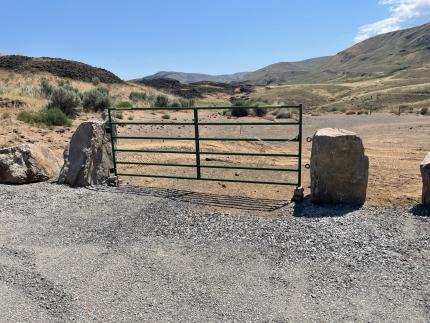
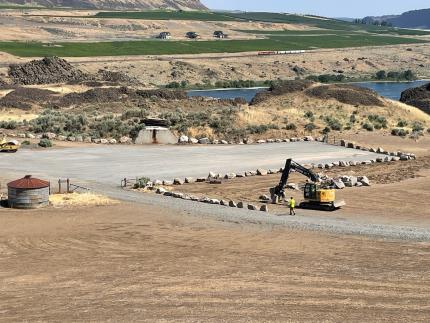
Manastash Ridge Trails and Evergreen Mountain Bike Alliance Volunteer Signage Day: Wenas Wildlife Area Manger Hughes, Specialist Frame, and Habitat Specialist Miller, with the help from volunteers, placed “Trail Closed for Restoration” and “Active Restoration” signs on trails within the Manastash Ridge trails. These trails are improperly built and often cause erosion. Closing them will help plants and wildlife return. The Wenas Team and volunteers also placed yield signs throughout the trails. This will educate users on how to properly yield to other types of user groups on the landscape.
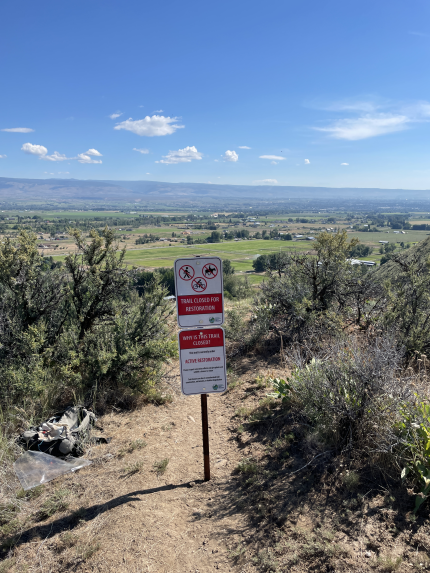
Providing Conflict Prevention and Education
Rattlesnake Hills Elk: Wildlife Conflict Specialist Hand prepared and delivered new damage prevention permits to landowners to address elk damage to commercial crops in elk area 3721. The summer bull season ended on June 30 with a new record of 31 bulls harvested on damage prevention permits. Late night and early morning hazing patrols are continuing along the Hanford National Monument border.
Franklin County Chicken Depredations: Wildlife Conflict Specialist Hand received and responded to a complaint of a fox that has raided a chicken coup and killed up to six chickens near Pasco. Enhanced protective fencing designs were discussed and encouraged as well as lethal removal and non-lethal hazing tools.
Kahlotus Deer Damage Claims: Wildlife Conflict Specialist Hand met with a producer who farms a large acreage wheat operation near Kahlotus concerning this year’s deer damage claim. The producer seemed very happy with last years coordinated hazing and hunting opportunities offered through both WDFW Special Permit hunters and Damage Permit Program, and is not looking at filing a crop damage claim this year.
Kittitas County Conflict: Conflict Specialist Wetzel worked with several hay growers who were having problems with elk in crops. Elk have been hazed from irrigated hay, row crops, and at haystacks. Elk are returning to the Parke Creek area, similar to last year.
Yakima County Conflict: Conflict Specialist Wetzel worked with several hay and orchard growers who were having problems with elk in crops. Elk have been hazed from irrigated hay, row crops, and orchard areas. Elk have been reported in the Naches River area in greater numbers than last year.
Conflict Specialist Wetzel Other: Conflict Specialist Wetzel assisted enforcement with trapping a bear that killed some chickens and was loitering in a neighborhood. The bear did not return to the area during the trapping period. Thanks to Rich and Lindsay for a new bear trap. It will be useful and safer to use.
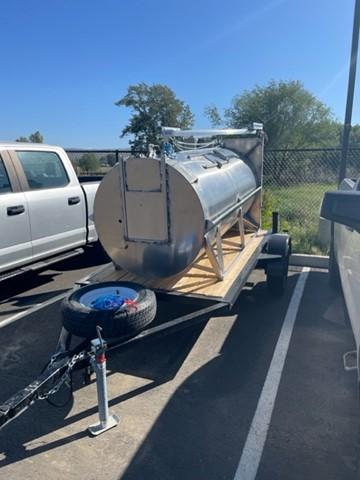
Conserving Natural Landscapes
North Durr Road Trash Clean Up: Wenas Wildlife Area Specialist Frame cleaned up 740 pounds of trash from the north Durr Road target shooting area. A box containing roughly a hundred 2023 WDFW Big Game Hunting Regulations pamphlets was found dumped and used as a target.
Whiskey Dick Cleanup: L. T. Murray Wildlife Area Assistant Manager Winegeart worked with volunteers to remove half a mile of old barbed wire from the L. T. Murray Wildlife Area’s Whiskey Dick Unit. All the wire removed was picked up and taken to recycle.
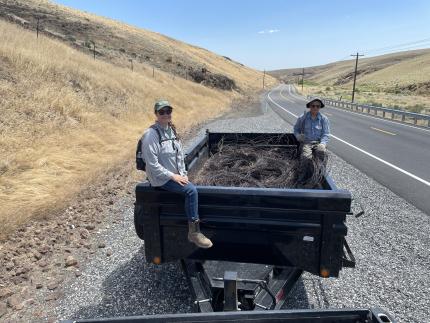
2022 Vantage Highway Fire: L. T. Murray Wildlife Area Assistant Manager Winegeart flew the Vantage Highway fire area in preparation of fall restoration work. Vegetation is recovering well in most of the fire area, but the loss of the area's big sagebrush and large woody riparian vegetation will be felt for many years.
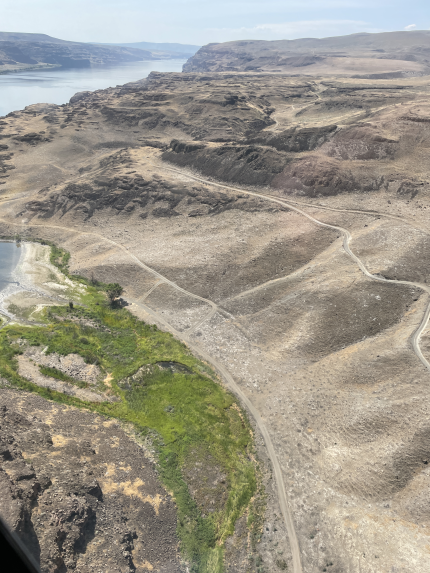
L. T. Murray Wildlife Area Assistant Manager Winegeart and Natural Resource Specialist Nass took photos at some Vantage Highway fire photo points. Most grasses and forbs seem to be recovering well and hopefully fall plug planting will aid in recovery of the missing shrub component.

Providing Education and Outreach
Stolen Shooter Man Sign: The Wenas Wildlife Area worked together on designing and fabricating a new sign to draw attention to target shooting restrictions throughout the wildlife area. The team hand drew and cut out the image below in metal along with developing a locking slider to allow for changing of signs within the metal shooter man. The sign will highlight target shooting restrictions year-round on the Wenas Wildlife Area. It will switch from green stating no timing restrictions, yellow stating sunrise to 10 a.m., and red saying no target shooting when in full emergency fire restrictions. After initially posting the sign at the entrance of Sheep Company Road, the sign was gone within 48 hours. Someone had grinded the metal sign off the post it was welded onto and cut out the yellow timing sign throwing it on the ground. The life-size shooter man sign was stolen. The wildlife area ended up taking an additional sign originally meant for another area and reposting it after adding additional precaution measures to prevent theft.
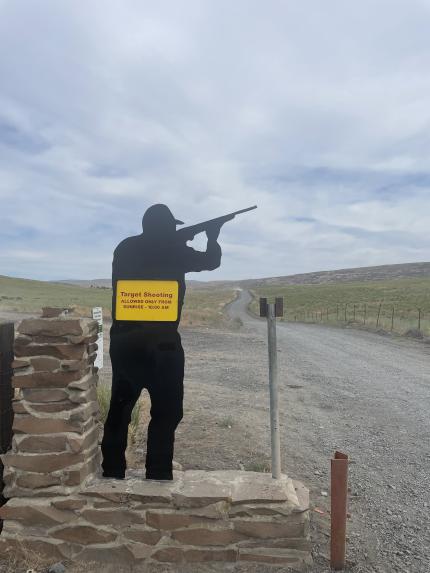
L. T. Murray Wildlife Area Manager Morrison and Assistant Manager Winegeart worked with volunteers to rebuild the Corrals kiosk which was lost in the Vantage Highway fire of 2022.


Other
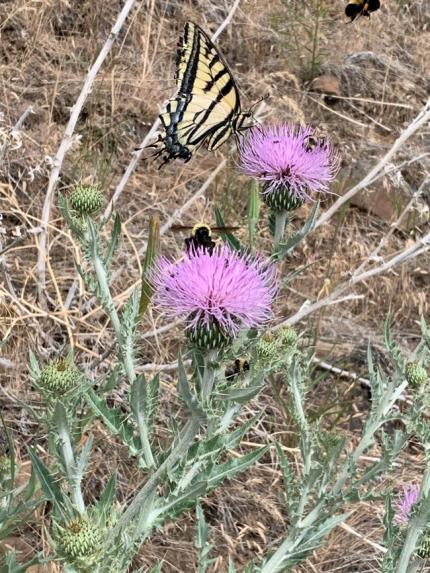
Managing Wildlife Populations
White Nose Syndrome Probiotic Bat Captures: District 13 Wildlife Biologist Licence, Diversity Program staff members, US Fish and Wildlife Services (USFWS) biologists, and WDFW Wildlife Veterinarian Dr. Haman gathered at an annual study site in the Darrington area to capture and sample a maternity colony of Yuma myotis. Although captures were relatively low on the first capture night, team spirits were high, and the bats appeared healthy. This research effort is a novel approach to utilizing naturally occurring bacteria to reduce impact of the causative agent of White Nose Syndrome (WNS). One more capture event is planned for later this summer.
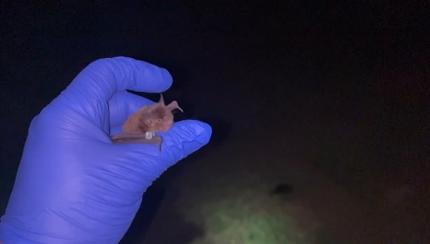
Island Marble Butterfly (Euchloe ausonides insulanus) Monitoring: Wildlife Biologist Licence, Diversity Program staff, and numerous other partners wrapped up a productive field season of island marble butterfly (IMB) and host plant habitat monitoring. With a significant reduction of host plant habitat in a core occurrence area for IMB this year, it has been a busy year for dispersal which has resulted in IMB occupancy at two new Candidate Conservation Agreement with Assurances (CCAA) properties! WDFW and USFWS staff members piloted numerous new tools for habitat monitoring including a Rapid Habitat Assessment protocol and drone surveys.

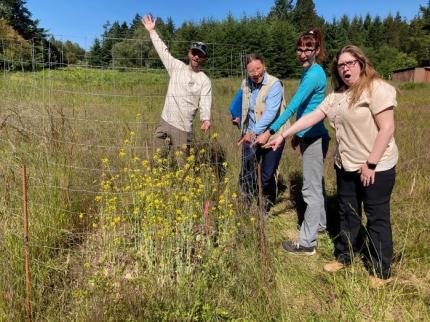
Sand Verbena Moth (Copablepharon fuscum) Surveys: Opportunistic and targeted surveys for species of Greatest Conservation Need, sand verbena moths, on San Juan Island were successful this year with numerous moths captured and documented. District 13 Biologist Licence, Diversity Program staff members, and partners captured moths via net and ultraviolet moth traps. These surveys help document and inform our understanding of species distribution for an understudied and charismatic invertebrate.
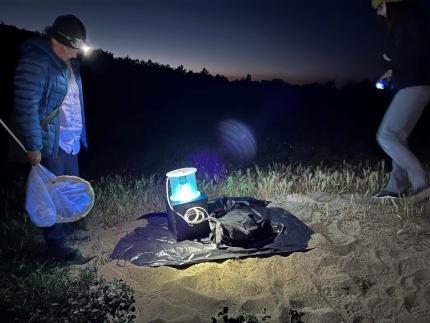
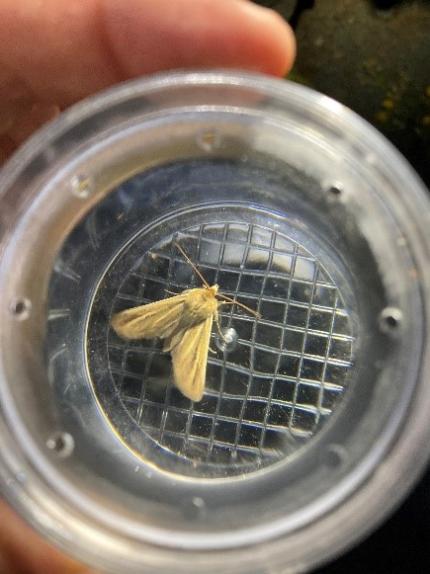
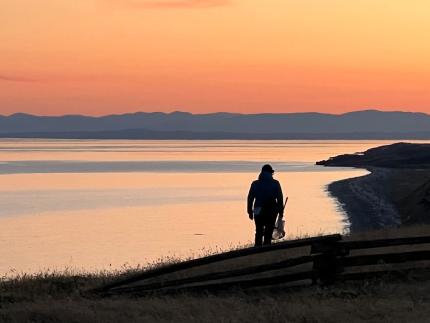
Propertius Duskywing (Erynnis propertius) Surveys on Orcas Island: Diversity staff members, District Wildlife Biologist Licence, and Lummi Nation biologists conducted a second round of propertius duskywing surveys associated with a Competitive State Wildlife Grant on Turtleback Mountain of Orcas Island. These “pre-treatment” surveys will provide a baseline indicator of duskywing presence prior to habitat improvement treatments to species host plant, Gary oaks. Once habitat improvements are completed, “post-treatment” surveys will be conducted to monitor any changes in the local duskywing population.
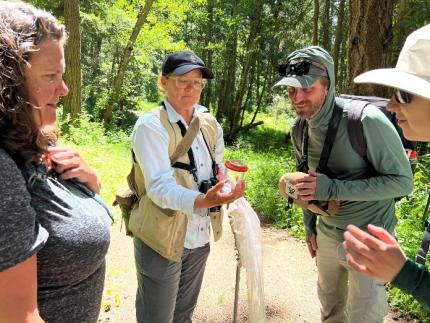
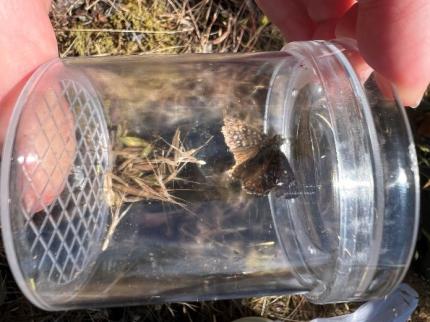
Blue Mountain Elk Calf Captures: District 13 Biologist Licence traveled across the state to join the top-notch capture team of the Dayton Game Management Unit (GMU) 162 to wrangle, collar, and collect data on numerous elk calves. One of the primary objectives of the study is to monitor survival and determine mortality causes of calves of the Blue Mountain elk herd.
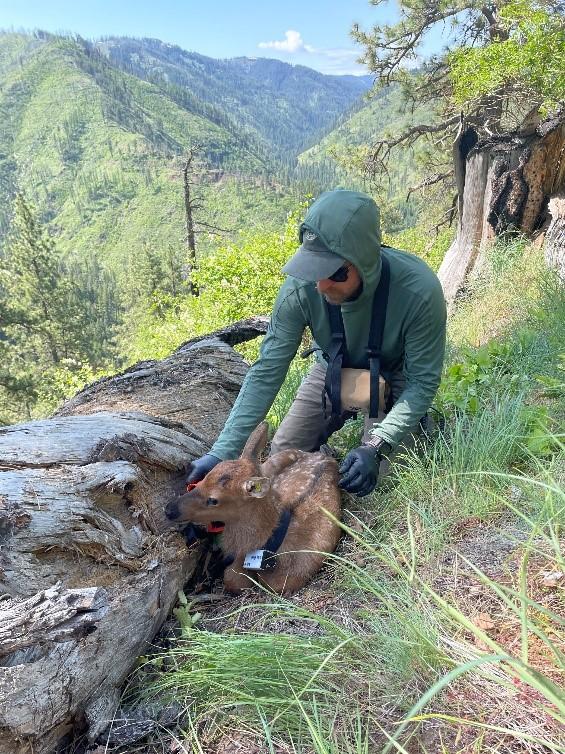
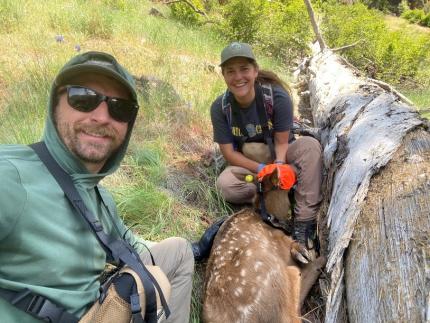
Managing Wildlife Populations
White-nose Syndrome Monitoring: Biologists Holman and Stephens collected bat guano at a known maternity colony site in Lewis County in order to have it tested for Pseudogymnoascus destructans (Pd), the fungus that is known to cause white-nose syndrome in bats.
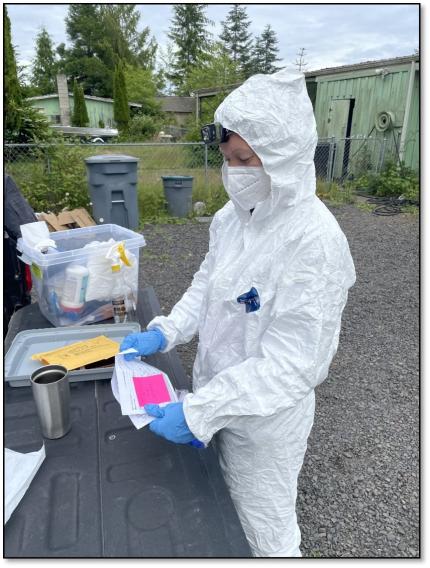
Bat Maternity Colony Counts: District 10 Biologists Holman and Stephens, along with Diversity Bat personnel and additional Region 5 staff members from Wildlife and Habitat programs, have conducted bat emergence counts at several maternity bat roosts in District 10. All of these roosts are in human made structures such as barns, homes, and sheds and these colonies have been reported by the landowners on WDFWs bat colony reporting form. WDFW biologists are grateful for landowners who take the time to report colonies and who allow us to come count bats on their property. Collectively, these partnerships are very meaningful for learning more about Washington’s bat populations. Two new colonies were counted this month, one of which had over 500 Yuma myotis and a second had over 1,000 bats which consisted of little brown bats, big brown bats, and Yuma myotis.
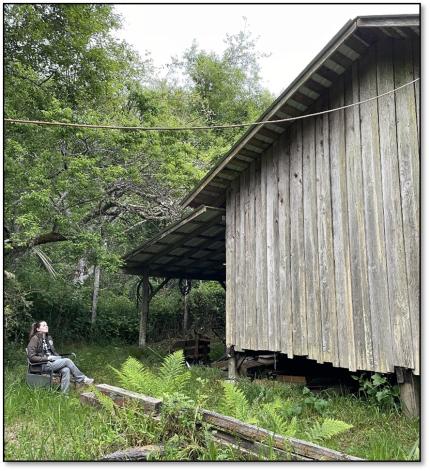
Snowy Plover Survey: Biologist Stephens assisted Region 6 Wildlife staff members with a snowy plover survey on Midway Beach. The snowy plover is listed as endangered in Washington and is federally threatened. The survey went well with around 15 birds recorded, some of which were able to be individually identified by unique color band combinations.
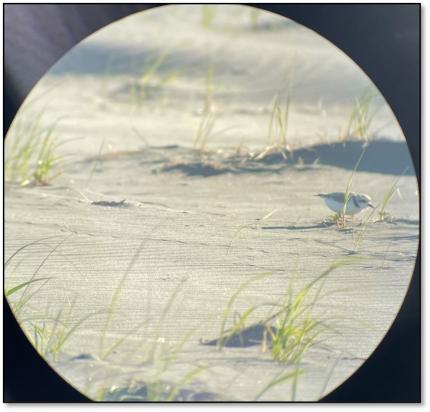
Western Gray Squirrel Investigation: Biologist Holman teamed with U. S. Forest Service Biologist Jakubowski to investigate the location of the recovery of a western gray squirrel carcass outside of the species’ known home range in Washington. The western gray squirrel carcass was submitted to the U. S. Forest Service by a citizen squirrel savvy enough to recognize that it was a species outside of its traditional range and of conservation concern (State Threatened). The specimen was found in wet conifer dominated U. S. Forest Service managed lands in eastern Lewis County, at least 40 miles direct line distance from the nearest known populations in Klickitat County. The squirrel has been transferred to the University of Washington Burke Museum for safekeeping.
Holman and Jakubowski searched the area of the recovered squirrel for any signs of squirrel activity including locating nests, as well as listening and looking for western gray squirrels. Additionally, the duo set motion-activated cameras baited with nuts to see if more western gray squirrels might potentially be in the area. After approximately six weeks, the cameras only revealed Douglas squirrels, Jays, and bears taking advantage of the bait. The investigation will continue during the winter when food resources are more limited, and bears are hibernating.
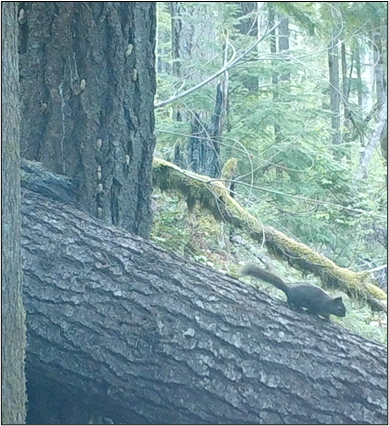

South Cascades Fisher Survey: In May and June, Biologists Wickhem and Bergh, and Technician Motiff with the help of Volunteers Hanley and Flick, removed 13 fisher monitoring stations that were deployed back in October and November 2022. The stations are made up of a PVC “scent dispenser” bolted to a tree that regularly drips very stinky lure onto a cow femur (bolted to the tree below the dispenser). A motion-detection trail camera is placed on an adjacent tree facing the station to catch any critter that comes to check out the smelly set-up. In all, there were 107 of these stations deployed in the Southern Cascades between the Columbia River and Snoqualmie Pass by WDFW personnel and partners from Department of Natural Resource, U. S. Forest Service, U. S. National Park Service, Woodland Park Zoo, Conservation Northwest, and Muckleshoot and Puyallup tribes. The stations retrieved by District 9 staff members were located in Clark, Skamania, and Klickitat counties, primarily deployed within the Gifford Pinchot National Forest or on adjacent Washington Department of Natural Resources land. Of the 13 stations collected, one camera was stolen, one camera malfunctioned, and three stations captured fishers. As usual, the cameras also collected images of many other forest critters including tree squirrels, flying squirrels, birds, rabbits, weasels, coyotes, bobcats, cougars, bears, deer, and elk. The station equipment is placed in the trees at least ten feet up from the ground, and one station north-west of Carson experienced snow deep enough to nearly cover both the dispenser and the camera. We are excited to hear the results from the 94 stations and wish our counterparts in the North Cascades good fisher luck when they deploy their stations this fall.
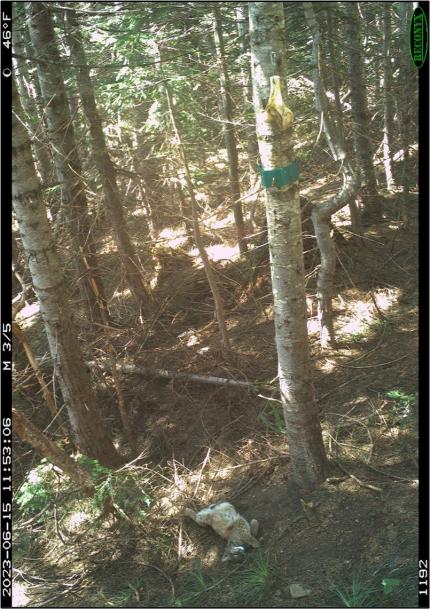


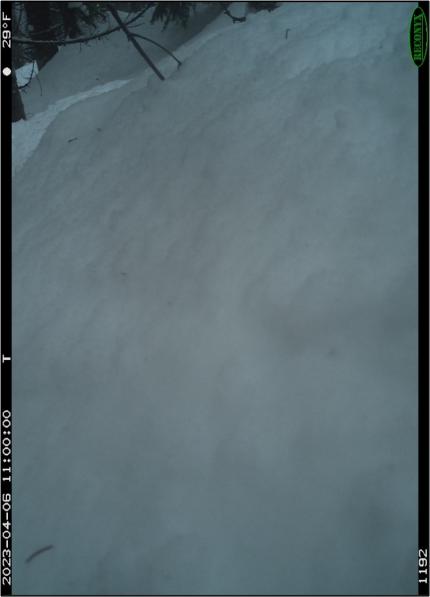
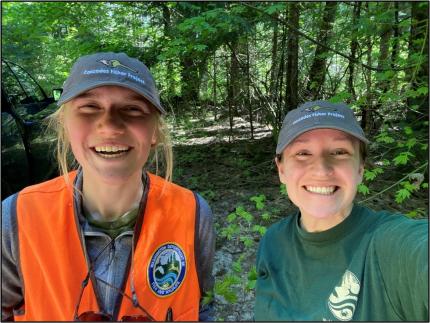
Providing Conflict Prevention and Education
Cougar Kitten Capture: Wildlife Conflict Technician Kolenberg received a phone call on Friday, June 23 about a cougar kitten that began to show up on a resident's trail camera in Kalama. The individual believed that the cougar’s mother may have been killed a week and a half earlier in a depredation incident on a neighboring property. Technician Kolenberg followed up with the individual who was involved with the depredation incident and confirmed that the female was lactating at the time of the depredation. Technician Kolenberg conferred with Specialist Jacobsen and Carnivore Specialist Beausoleil and decided setting traps was our best option for the cougar kitten. Technician Kolenberg and the resident set three traps and spent some time calling for the cougar kitten on Friday afternoon. Over the weekend the resident provided updates and informed Wildlife Conflict Technician Kolenberg that on Saturday night a neighbor spotted two cougar kittens. On Monday evening, the resident called Technician Kolenberg alerting him that he and his neighbors had caught one kitten, and were in the process of capturing another. Technician Kolenberg arrived at the scene just around sunset and assisted with the capture of the second cougar kitten. It was a whole neighborhood effort as up to ten neighbors on the block were out assisting in this incident. Technician Kolenberg brought the two kittens back to Ridgefield and then transferred them to Specialist Jacobsen, who transferred them to Specialist Beausoleil in Toppenish. Specialist Beausoleil will keep staff members updated on what the future holds for these cougar kittens. Huge thanks to the neighborhood in Kalama that spent the time checking traps and assisting with the capture and welfare of the cougar kittens, as well as Specialist Jacobsen and Specialist Beausoleil for the guidance!
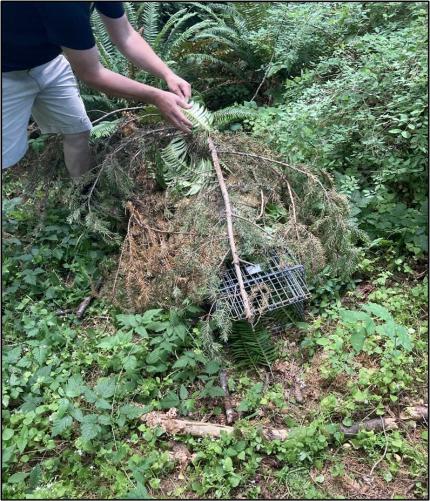
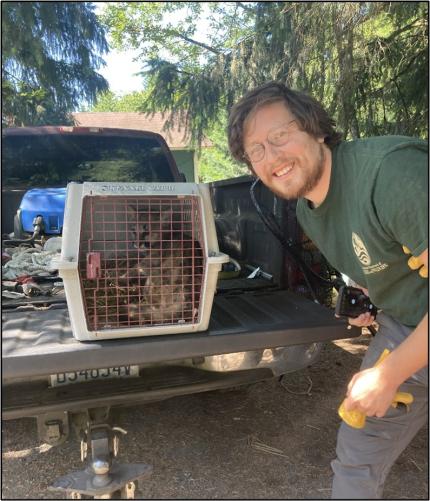
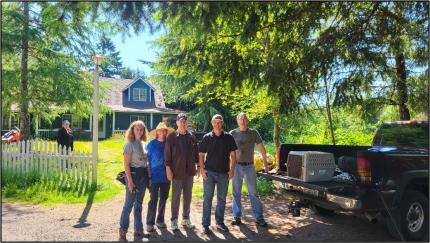
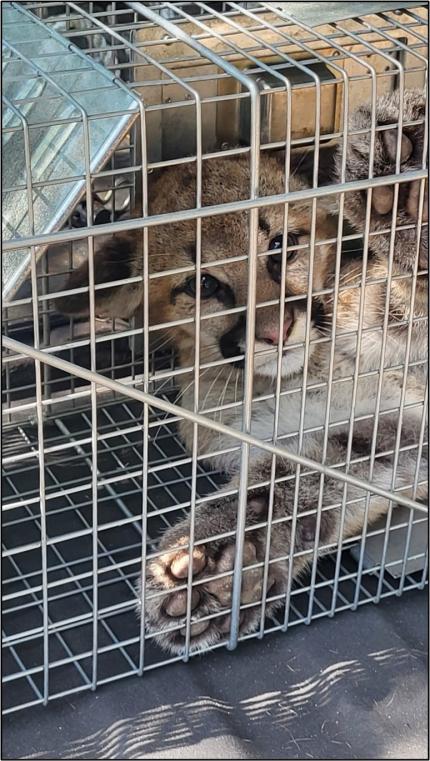
Conserving Natural Landscapes
Removal of Derelict Fences on the Klickitat Wildlife Area: Master Hunter Volunteer Rudberg came to the Klickitat Wildlife Area to help Assistant Manager Hunt pack out spools of barbed wire that were cached in various remote locations from this year’s previous fence removal projects. The Klickitat Wildlife Area has several old fence lines that are no longer needed or maintained. These fences present unnecessary obstacles and can entangle the feet of animals and people, so it is best to remove them. Master Hunter Rudberg and Assistant Manager Hunt spent a full day packing out barbed wire and disposing of it at the Goldendale Transfer Station. Assistant Manager Hunt appreciated Master Hunter Rudberg’s dedication, resilience, and positive attitude during a tough day of off-trail hiking and hot summer temperatures.
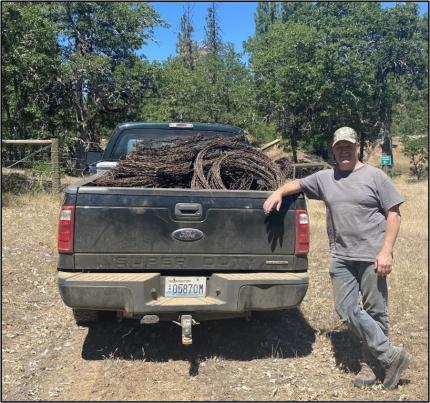
Managing Wildlife Populations
Snowy Plover: Biologists Cent and Novack completed the third and final round of breeding adult snowy plover surveys with the help of various WDFW staff members. Below is a summary table of the adults observed during the three surveys (“visits”) in 2023. Numbers at Midway Beach continued to trend downward compared to prior years. Plover observations were fairly consistent at Conner Creek and Copalis Spit. Six nests were discovered at Midway Beach during survey efforts, three nests were discovered at Copalis Spit, and one at Conner Creek. Three chicks were observed in the final survey at Midway Beach. Biologist Cent will continue to monitor active nests as time allows.
|
Site |
Visit 1 |
Visit 2 |
Visit 3 |
|
Midway Beach |
10 |
14 |
12 |
|
Conner Creek |
2 |
0 |
4 |
|
Copalis Spit |
5 |
5 |
5 |
|
Oyhut Spit |
0 |
0 |
0 |
|
Ocean Shores |
0 |
0 |
0 |
Streaked Horned Lark: Biologists Cent and Novack completed the last round of lark surveys. Below is a summary table of the three surveys completed during the 2023 breeding season. After a site visit to Damon Point showed the habitat was no longer suitable for breeding larks, Biologist Cent determined the site did not need to be surveyed in 2023. The habitat at Oyhut Spit (adjacent to Damon Point) is now very marginal, which likely explains why no larks were observed this season. Numbers of larks at Shelton Airport and Midway Beach were similar to the last surveys conducted in 2018, with a slight increase at Midway.
|
Site |
Visit 1 |
Visit 2 |
Visit 3 |
|
Midway Beach |
10 |
10 |
9 |
|
Shelton Airport |
7 |
3 |
6 |
|
Oyhut Spit |
0 |
0 |
0 |
Conserving Natural Landscapes
Protection Island: Wildlife Area Manager Laushman, Prairie Specialist Cook, and Biologist Norris worked with a Sound Native Plants crew to spend time working on weed removal and dune grass transplanting on Protection Island, part of the North Olympic Wildlife Area.
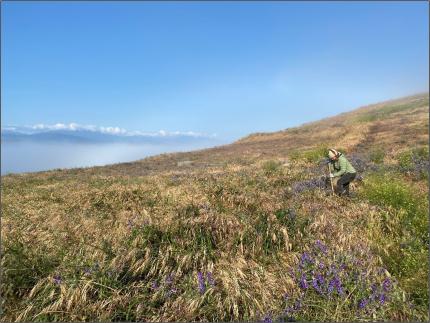
McNeil Island: Wildlife Area Manager Laushman treated noxious weeds including Japanese knotweed and tansy ragwort on McNeil Island.
Irondale Beach: The Water Access team assisted Wildlife Area Manager Laushman in cutting overgrown vegetation around the parking and trails at Irondale Beach, of the Chimacum Unit, and refreshed signage.

Irondale Beach: The Water Access team assisted Wildlife Area Manager Laushman in cutting overgrown vegetation around the parking and trails and refreshed signage at Irondale Beach, of the Chimacum Unit.
Lands 20/20: Biologist Novack submitted an initial draft proposal for land acquisitions along the Chehalis River Valley in Grays Harbor County.
National Association of Clean Water Act (NACWA) Grant: Biologist Novack provided review and support to partners with Ducks Unlimited for their application for federal funding from NACWA. WDFW is providing match dollars from property acquisitions that have already occurred or are funded for the next fiscal biennium. The grant proposes to undertake wetland enhancement and restoration actions on public and private lands within Thurston and Grays Harbor counties.
Conducting Business Operations and Policy
Customer Service: Biologist Novack has handled several questions from hunters after the permit draw results were posted.
McNeil Island: Wildlife Area Manager and Assistant Regional Wildlife Program Manager Blankenship attended the quarterly McNeil interagency meeting to facilitate coordination and planning on the island.